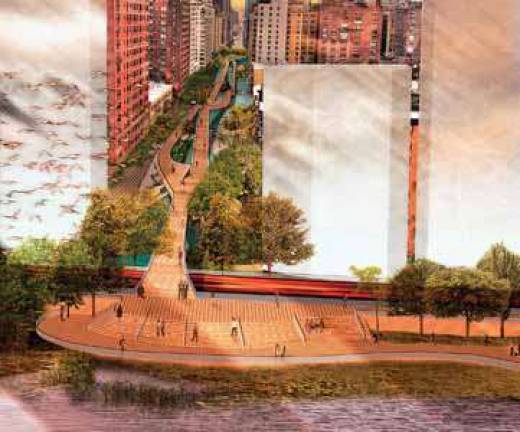Exhibit Imagines Canals & Other East River Park Delights

by Rebecca Harris The shabby state of Manhattan's East River Esplanade, crumbling with age and plagued by awkwardly configured spaces, minimal amenities and deterioration due to a general lack of upkeep, has been a source of displeasure for East Siders for years. City Council Member Jessica Lappin has said her office receives frequent calls from residents of East Harlem and the Upper East Side complaining about the condition of the waterfront area between 60th and 125th streets. "Many of us on the East Side have been very jealous, for a long time, of what West Siders have to take advantage of when it comes to their waterfront parks," she said. Now, city officials and community advocates have begun soliciting feedback in their mission to craft a vision for an ambitious improvement of the aesthetically neglected East River Esplanade. Canals weaving inland, intertwining with Manhattan's city grid; a network of modern boardwalks spiking out into the water off the shoreline; advanced irrigation systems; and dramatic landscaping are just a few examples of designs for the new park put forth by the winners of a Civitas ideas competition. Civitas, a nonprofit organization that works to improve urban planning and land use policies on the Upper East Side and East Harlem, launched the contest in the fall of 2010, encouraging architects from around the world to submit proposals for creative development of the Esplanade. The competition drew 90 submissions. "We looked at other great spaces in New York City-Hudson River Park, the High Line-how did they get their start," said Hunter Armstrong, executive director of Civitas. "With a comprehensive vision coming from their community with an ideas competition." The winners were chosen by a panel of eight judges: six architects, a zoning attorney and William Castro, the Parks Department's Manhattan borough commissioner. Requested improvements included expansion of available activities, integration of existing features and increased access to the waterfront, among other criteria. Lappin called the winning designs inspirational. "Coming up with the vision for what we want shouldn't start out from a place that's restricted to what we think we can do, but with what we would love to do," she said Submissions to the Civitas competition were not restricted by financial feasibility or zoning requirements. Armstrong noted that the winning designs may not necessarily come to fruition in development of the Esplanade. "We wish there were major dollars at the end of this to implement some of these designs, but obviously work is needed to build that political and community support. This was a creative process to?pool in the community, constituents and stakeholders and get them to start thinking about the future of the park," he said. The Museum of the City of New York unveiled its Reimagining the Waterfront exhibition, which showcases the contest's three winners and five honorable mentions, two weeks ago. The exhibit will be on display through Oct. 28. First-place winner , an architecture graduate student at Syracuse University, produced a design plan that integrates the Upper East Side and East Harlem neighborhoods adjacent to the river by extending the boundaries of the waterfront inland via canals. "I think, different from all the other projects, my idea was the thought of pulling the water into the city, bringing the waterfront to the people," said Wood, who added that he, like many of the winners, had not actually visited the Esplanade while crafting his ambitious design. Takumo Ono and Darina Zlateva of New York City and Matteo Rossetti of Italy won second and third place, respectively.